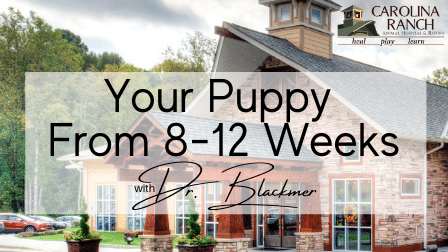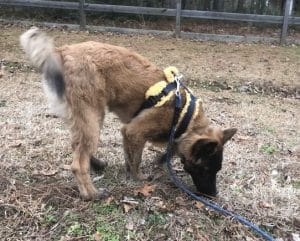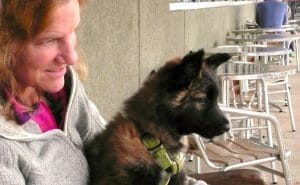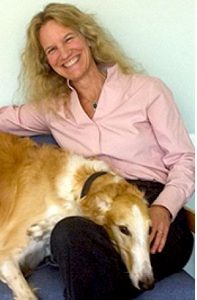Your Puppy From 8-12 Weeks

GOALS FOR THE FIRST MONTH
- Sleep peacefully through the night (our crating blog will also be helpful)
- Potty outside
- People are fun!
- Safety and fun with the pack, human and animal
- Keeping teeth on toys not hands
Having your puppy trained at a young age can help them to become more obedient, improve their behavior and can help them to develop their social skills. The ideal period for puppies to start socializing is between 7-12 weeks. During that period, having your dog socialize with other dogs and professional trainers can help them to form bonds and become more accustomed to the world around them.
Having your dog trained at a young age can help them to correct any bad behaviors early on and can teach them to become good citizens. Training your dog while they’re still young can also help them to develop their social skills and pick up good behaviors they see in other dogs. Typically, the best age to have your puppy professionally trained in obedience is between 7-8 weeks.
While 8-week-old puppies will take longer to potty train, it’s always good to start early and housetrain them slowly. Providing positive reinforcement when they use a puppy pad or use the bathroom outside can help them to learn those behaviors and repeat them. However, the ideal age to start potty training is between 12-24 weeks. During this period, your dog will be easier to potty train and will be able to pick up good behaviors more quickly.
GETTING THE HOUSE READY
You’ll want to make sure your house is set up and ready to go. If your puppy isn’t with you yet, check out the blog, “Before Our Puppy Comes Home” which goes over the details of preparing yourself, your family, and your home for that wonderful day when your puppy arrives. I suspect, if you’re reading this blog that your puppy has already arrived. So, let’s go from there!
CRATING
Our blog “A Gated Community – Crating Your Puppy” is focused on this very important topic, so see the details here:
HOUSETRAINING
Timing and awareness are the two keys with housetraining. If your puppy never has an “accident” in the house (wouldn’t that be amazing??), then she’s learning the correct behavior from day one. Here’s how to set her up for success:
- Choose the potty location – for most people that’s going to be outside. It’s much harder to transition to pottying outside later on than to use the outdoors from day one, so if you’ll want your puppy to use the great outdoors, do that from day one rather than newspapers or puppy pads in the house.
- Choose the surface – generally we’ll want our puppies to be willing to potty on various surfaces, so let’s make that part of the process from the start. Every few days or so, switch it up – grass, gravel, mulch, dirt, pine straw, etc. If you have a specific potty location, use it from the start and voila, she’ll want to go there regularly for the rest of time. (That’s a double-edged sword. Believe me, I know, as I inadvertently trained one of my dogs to urinate on the front steps. In my defense, she came to us in February and right by the front steps was a convenient place to take her at 4 am in my PJs. Lesson learned!)
- Create the set up – Limit your puppy’s ability to explore when she’s supposed to be focused on pottying. One option is to use a leash. This is especially useful if you live in a townhome or apartment. Because I have my own yard, I found it very useful to set up an exercise pen (aka ex-pen) outside. This is especially helpful if your puppy isn’t yet comfortable on a leash. Make the ex-pen big enough for your puppy to move around – ~4 ft on a side for little breeds, ~5 ft for medium, and maybe a little bigger for large breeds.

- Timing – Puppies need to urinate and/or defecate after waking up, after eating, and after playing. Start with those as set times to take your puppy to her potty area. Initially, when she’s awake, you’ll also want to take her out every hour or so. After the first week or two, it can be about every 2-3 hours.
- Awareness – in addition to the timing outlined above, watch for the key signs your puppy needs to go out. Most puppies will stop what they’re doing and start sniffing the ground – that instant is when you need to head outside. When she’s little (<10-12 weeks), just gently pick her up and carry her to the potty area. When she’s a little older, call her in a “happy” voice, pat your leg and head for the door together.
SOCIALIZATION
The key window for puppy socialization is from 7-12 weeks of age. Done properly, socialization can prevent a host of problems that often result in relinquishment of teenaged dogs to shelters. So, let’s get this one going early!
Socialization is all about positive reinforcement associated with seeing and experiencing things in the world. Interestingly, the puppy won’t necessarily have to interact or touch most of those things. For example, sitting in your lap eating something delicious while watching a woman wearing a big, floppy hat as she walks by gives the puppy a positive association about women wearing big, floppy hats. Neither the woman nor the hat has to touch the puppy! I find one of the best places to take my puppy for socialization is outside the grocery store on a Sunday morning. Everyone is heading there and has a purpose.
While some folks might stop to say hi, most won’t, and that’s absolutely fine! For those who do want to say hi, have some tasty treats for them to feed to your puppy. Watch your puppy carefully. If she seems interested (leaning forward, ears up, tail wagging), all is fine with what you’re doing. If she seems worried (leaning away or ears back/down or tail low or tucked), then what you’re doing is too much, so back off for the day. Sometimes just giving some distance is all that’s needed. Sometimes it’s time to pack it in and go home and that’s fine. For a lot of puppies they’ll have days when they’re all about meeting and seeing new things and other days when they’re feeling more sensitive. Listen to your puppy and do what she needs on any given day.

What about other dogs? Well, you don’t want your puppy to be afraid of other dogs, but many dogs won’t spend their lives needing to interact with lots of other dogs they don’t live with. So, the same rules apply – seeing from a distance (and eating delicious treats) gives you a huge benefit. The Holy Grail for most folks will be that your dog can share the street with other dogs and not come unglued barking and pulling to go say “Hi”. If that’s your focus, work on seeing from a distance and getting cookies. Slowly build up to moving with you when other dogs are around while your puppy keeps her focus on you. That’s really all you need. The key is to always keep far enough away that your puppy can eat treats and maintain her focus on you. Decrease the distance between your puppy and other dogs over the course of weeks to even months.
Playing with other puppies is something I would aim for in the safety of a puppy class. Be very cautious about letting your puppy play with adult dogs you don’t know. Many people assume that since their adult dog is good with other dogs, he’ll be good with puppies. That isn’t always the case. Make sure both the adult dog and your puppy are on leash and be very vigilant. Accidents happen so quickly.
ANIMAL PACK MATES
Your own dogs are a different matter entirely. Let’s face it; many of us have more than one dog. At the time of this writing, we have 5! (Yeah, my husband is a saint.) So, the puppy needs to be integrated with the pack. Adult dogs come in three broad categories – love puppies, indifferent to puppies, and “Puppies are the devil, don’t even let them near me.” In our household, we have some of each.
Management is critical. When your puppy first arrives home, don’t let your adult pack overwhelm her. In fact, the safest approach is to keep the adults behind a baby gate or other barrier and allow them to sniff noses through the gate with you supervising. Start with the puppy in your arms.
We set up “mat time” with our adults twice a day – morning and evening. Before the puppy arrives home, we remind everyone of the game. Each dog is on his or her own mat or cot or bed and gets paid lavishly for staying there. (We use some of their breakfast and dinner for this “game”.) When the puppy comes home, teach the go to mat trick early. (We’ll go over this trick in our blog on skills and tricks coming soon.)
You can have the puppy join in with the pack from the first week by having her on a leash and on her own mat right beside you. This is a nice way to have controlled integration with the pack but the puppy can’t visit the adults and the adults should be trained to stay on their mats ahead of time. If you don’t have this set up, consider a small crate or ex pen for the puppy so she’s with the pack, beside you, but no unplanned interaction is possible.
Here’s a video of our pack quite a few years ago now with puppy Péle learning the mat game with the rest of the pack getting intermittent reinforcement as well.
When you start to allow interactions, start on leash (both adult and puppy) with only one adult dog at a time. As time goes on you can gradually start allowing more interactions but always monitored. Most of the time should be spent focused on you anyway – that’s where the training you want will happen.
As for cats, chickens, rabbits, and the like, follow the same plan as with the dogs – control the puppy’s interaction so she doesn’t practice naughty behavior. Ever. The goal is no chasing, no “playing”, no nipping. The best way to achieve that is to set up baby gates (or leash her) when the other animals are around. Pay handsomely for your puppy focusing you and not the cat running through the living room on the way to his dinner.
This is Rowan at 6 months of age. His family has worked really hard from day one on gentle interactions with the cats. When the cats were around, he spent the vast majority of his time behind baby gates or on a leash for those 6 months. The result is this lovely, gentle, and respectful relationship between Rowan and Quince. Believe me, this doesn’t happen overnight with an English shepherd (a herding breed and therefore very interested in other animals by nature). It took careful regular behavior management and training to get here.
HUMAN PACK MATES
Kids love puppies and most puppies love kids. Just like with the animal pack mates in the household, supervision is critical for success. Have a family meeting before the puppy comes home so that everyone is clear about the rules. Especially if you have younger kids, ensure you’re holding the puppy during initial introductions. There should always be an older, responsible and experienced kid or an adult present for puppy activities. Kids can be a great help training and playing with puppies, so let’s set everyone up for success. Find a puppy class where your puppy and her young human pack mate can attend. Our early puppy classes at Carolina Ranch Animal Hospital are a great start!
BITING, CHASING, MOUTHING
Puppies often treat little kids as littermates; consequently, nipping, chasing, and rambunctious play can be a real problem if you’re not planning ahead. Ensure you start puppy playtime with kids and adults sitting or standing still and the puppy on a leash. Have toys on hand to redirect the puppy to playing with those instead of nipping at quick moving hands and feet.
The key to preventing these challenges is to work on appropriate play from the start. Watch a litter of puppies and you’ll quickly see that chasing is a favored pastime. Ensure your little kids are staying still when playing with the puppy and you’ll be off to a good start. In the blog coming on tricks and skills we’ll go over some games you can play that are kid friendly.
LIBRARY
Here are some books and websites I recommend for puppy raising, cooperative husbandry, and training.
Books
- The Puppy Primer by Pat McConnell
- The Perfect Puppy in 7 Days by Sophia Yin
- Cooperative Care by Deb Jones
- Beyond the Back Yard: Train Your Dog to Listen Anytime, Anywhere! By Denise Fenzi
- Growing Up FDSA, Surviving Your Dog Sports Puppy by numerous authors (This ebook is available free at https://www.fenzidogsportsacademy.com/index.php/18637 )
- Susan Garrett’s Crate Games for Self-Control and Motivation by Susan Garrett
Websites and Blogs
- https://fenzidogsportacademy.com/ – all things dog training. This website started largely for people with dogs competing in dog sports and there’s also a lot for those interested in addressing building toy play, cooperative care, fitness/conditioning and preventing reactivity/fear. They’ve recently added a section on “Pet Dog Training” that has a lot of great workshops for pet dogs as well.
- https://hannahbranigan.dog/ - Hannah Branigan is one of my absolute favorite trainers. She’s a self-proclaimed geek about the whole dog training thing. She’s a serious dog sports competitor and has not just a blog but a podcast (“Drinking from the Toilet”) and a book (competition obedience).
- https://thecognitivecanine.com/ - This is Sarah Stremming’s blog about dog training, cooperative care, and positive approach to living with your dog.
- https://k9infocus.com/blog/ - Deb Jones is another positive trainer with a fabulous blog. She’s one of the key people to follow for the ins and outs of cooperative care.





